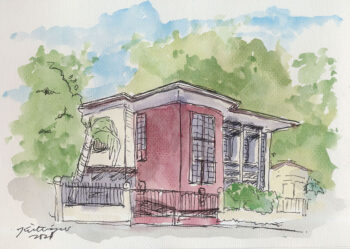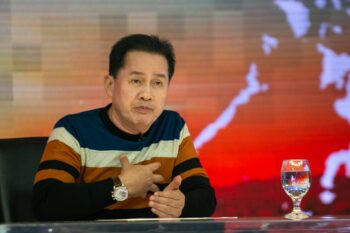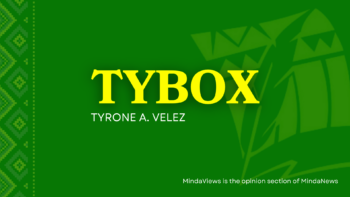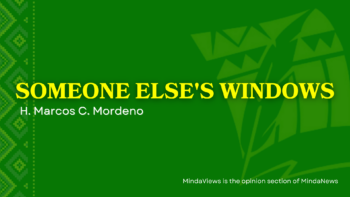
(This is an updated version of the sharing she made during the online forum “EDSA @35: Memories, Legacies, Uncertainties” on February 25, 2021. The forum was organized by the Ateneo Universities in the Philippines)
I did a double-take when I read the programme for today and saw the word “youth” beside my name. Fifty-two-year-old me hastily clarified with Atty. Meong Cabarde and heaved a sigh of relief with his clarification that I would be speaking “as part of the youth movement noon.”
The 35-year hindsight is significant because 35 years is the maximum in the range of years that constitute a generation. While the United Nations General Assembly defines youth as those between the ages of 15 to 24, the African Youth Charter classifies those from 15 to 35 years old as youth. So this would be the message of a 1986 young once to today’s young ones — a generation removed.
This afternoon I will be taking stock as a Mindanawon, specifically a taga-Davao. I was a young student-activist enrolled in the Ateneo de Davao in the year leading up to 1986.
Authoritarianism, dictatorship, and social inequities, to which the People Power Revolution was a response are certainly linked to Mindanao. Mindanao was used by the dictator Ferdinand E. Marcos as part of the justifications for declaring Martial Law in 1972. Mindanao figured prominently in Proclamation 1081, which mentioned Mindanao at least 13 times, associated with the terms “lawlessness,” “fear and panic,” “chaos and disorder,” “armed clashes, killings, massacres, arsons, rapes, pillages, destruction of whole villages and towns and the inevitable cessation of agricultural and industrial operations, and ” state of actual war.” If Mindanao continues to suffer from a negative image, Marcos and Proclamation 1081 certainly contributed to that.
I do not mean to denigrate the contributions of the people who were there 35 years ago. But as a Mindanawon, I have a huge discomfort with the use of “EDSA 1986” because it reduces the change process that we Filipinos went through and are still going through into a locus, event, and moment.
There are views that ascribe the ouster of the dictator Marcos to the “spontaneous” four-day mass-up of Filipinos along Epifanio delos Santos Avenue in response to the call of Cardinal Sin to support coup plotters led by then-Defense Minister Enrile and then-General Ramos. Thus EDSA as locus, event, and moment.
Unfortunately, these narratives do a disservice to many Filipinos around the country who struggled for social transformation, thus helping create the conditions that made it possible for the 1986 national shifts to transpire.
People Power Revolution ito, this photo of protesters in Jones Circle, Davao City during the groundbreaking Welgang Bayan of 1984, which dramatized the swelling protest against the dictatorship. It signaled a floodgate of political actions. Later in the year, transport strikes also paralyzed many places in Metro Manila, Luzon, and Visayas, including Davao, Butuan, Cagayan de Oro, Bacolod, and Cebu. At ito rin People Power Revolution, workers from Davao City and Sta. Cruz, Davao del Sur during the campaign for the presidential elections of 1986.
And let us not forget that among the first to have spoken out against the abuses of Marcos’s Martial Law was Davao Archbishop Antonio Mabutas who issued the statement “Reign of Terror in the Countryside” in 1978 condemning the killings of church workers in Davao City.
My point is perhaps people from around the country and all walks of life would connect better to the commemoration of February 25 if we stop privileging EDSA and, by extension, Metro Manila.
The tag EDSA is certainly shorter than People Power Revolution and easier in the delivery. But of what use is that if it fails to invoke among the population the very values that are said to imbue it: unity, heroism, democracy, and nationalism, among others?
Much has been said about the failure of the teaching of history as events because it regrettably gets reduced to memorizing the names of stellar personages, places, and dates.
Though certainly challenging, perhaps we would have connected better to the Filipino youth post-1986 had the emphasis been on developing the skills of integrative thinking in addition to critical thinking and connecting the People Power Revolution to local narratives.
For instance, I wonder how many students of the Ateneo de Davao University are aware of these names: Eduardo “Taking” Lanzona, Nicolas “Nick” Solana, Jr., Ma. Socorro Par, Ricardo P. Filio, Joel Ozarraga Jose, Evelia Bontia, Magtanggol Roque, and Laurente C. Ilagan.
They are but some of the faculty members and students of the Ateneo de Davao who resisted the Marcos dictatorship. They are honored by the Bantayog ng mga Bayani as heroes and martyrs.
Like many others, I subscribe to the view that remembrance and commemoration are not just about the past, they are ultimately relevant to our present and future. I also believe that the true power of memory is in its application in contemporary times.
Post-EDSA, Mindanao experienced changes in its politico-institutional infrastructure. The Mindanao Economic Development Council or MEDCO, which has now become the Mindanao Development Authority or MINDA is one of them. We are aware that it is the only sub-regional mechanism of its kind because Luzon and the Visayas do not have their own.
While there have been changes in the Mindanao socio-economic scene and the political capital has informally shifted from Malacañang to Panacañang to Doña Luisa, one wonders if the changes are significant enough to put an end to the biting critique of former Senator Aquilino Pimentel, which I will paraphrase: That Mindanao and its peoples are the cash cow that gets peanuts.
President Duterte’s rise to power was aided in no small measure by the youth vote and their activities in social media. I have a few choice points for the youth of Davao and I apologize for having to draw parallelisms. But it is important to recognize that you are today where the youth of Northern Luzon were in the context of Marcos and the so-called Solid North.
In a presentation this morning, Atty. Ross Tugade presented a study titled “Demystifying the Marcos and the EDSA Legacy reflected in the notion of the Solid North.” The study pointed out that “youth support is crucial for reconstructing memories and maintaining political power.”
In the same manner that it is simplistic to allude to an absolute Solid North in the context of Marcos, I also think it is simplistic to say that Davaoeños, particularly the youth of Davao, are unqualified in their assessment of and stand in relation to the current national leadership.
But I must admit that this is where our integrative thinking capacities will need boosting to help us overcome the all-too human tendency to be clouded and limited by regionalism, and thus unqualifiedly accept and stand by what we regard as “one of our own.”
I argue for integrative thinking because it would enable young people to deal with tensions and uncertainty, which connects to the forum theme of “EDSA @35: Memories, Legacies, Uncertainties.” Integrative thinking also develops a high openness and tolerance to change and the ability to recognize salience or relevance, causality, sequencing, and resolution, which are all necessary to initiate and achieve social transformation.
Going back to ADDU’s martyrs and heroes, perhaps if more members of the ADDU community are aware of their very own heroes and martyrs, they would be more emboldened and inspired, which help overcome what Pope Francis referred to as pusillanimity or faintheartedness, “the sin against memory, courage, patience, and hope.”
We have often heard the adage “Never Again” to authoritarianism and dictatorship. But we in Konsyensya Dabaw remind our counterparts that as far as Martial Law is concerned, this no longer applies. Simply put, we have experienced Martial Law once again—well twice again in fact because Martial Law was declared in Mindanao for a total of three times starting with 1972. Further, in the context of how national government under the Duterte administration is responding to the different crises that have beset our country, civilian supremacy over the military is something that can be debated.
This is why I believe that the more nuanced call is really “Not on Our Watch” rather than “Never Again.” I hope that the youth of today would continue to reply with “Not on Our Watch!” to the all-too-real threats of authoritarianism, militarism, and dictatorship.
It has been said that the People Power Revolution of 1986 and its heroes transformed the Philippines in the context of what needed to be changed in that particular period of our nation’s history. Today the Philippines continues to be in need of transformation and, thus, in need of more heroes.
It is up to the youth of this generation to define the “heroism” that is appropriate to this time and what Filipinos need to work on and achieve as the next Peoples’ Project. Hopefully, they will be able to see the connectedness of the struggles of half a century ago to their own projects for the nation.
I also ask today’s youth to not fritter away the heroisms of the past and their gains. I trust that the Filipino youth of this generation would lead the break from leaders who offer strong-arm solutions that only erode the rights restored in 1986. I am confident they know that disregarding human rights would be tantamount to pulling out the very rug from under their own feet.
As a personal post-script, please allow me to share that when Ninoy Aquino was assassinated in 1983 and all my high school classmates were convinced that Marcos was behind it, I was the only one who wanted to give Marcos the benefit of the doubt.
What saved me from a life of cluelessness and apathy?
Beginning 1985, the Ateneo’s formation and academic programs, the youth and student’s movement, my community of teachers and mentors like Ma’am Bing Sobrevega-Chan and icons like Tito Karl Gaspar and the Mansayagans, and the socioeconomic and political context of Davao exposed me to urban poor, workers, farmers, women, Bangsamoro, and Lumad who were involved in various struggles to assert their rights and sectoral agenda.
Not long after that I made a choice to stand with them because the Mindanao and the Philippines that they were aspiring to transform and win are my Mindanao and Philippines, too.
And that choice motivates me to continue to try and be the person for others that Ateneo dares me to be every day.
Daghang salamat. Shukran. Fiyo bagi.
(MindaViews is the opinion section of MindaNews. Mags Z. Maglana is a Mindanawon activist and worker for peace and development)







